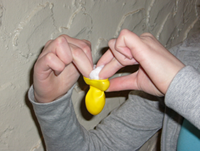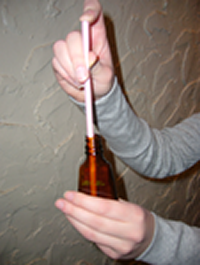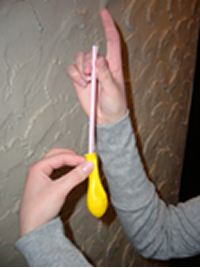
You may not have ever heard of the word diffusion, but you experience its effects everyday! Diffusion is defined simply as the movement of things from where they are more concentrated to where they are less concentrated.
Age Appropriateness
8-11 years old
INTRODUCTION
You may not have ever heard of the word diffusion, but you experience its effects everyday! Diffusion is defined simply as the movement of things from where they are more concentrated to where they are less concentrated. Concentrated means how much of something there is in a certain place. An example of diffusion you probably have experienced is if someone sprays perfume and you are standing on the other side of the room you will not immediately smell it. However, wait a little bit and the smelly molecules will eventually diffuse through the air to your nose!
Additionally, molecules are so small that sometimes they can even diffuse through something that seems solid, such as a balloon! Have you ever noticed that balloons lose their air over time? That is due to the air "leaking" out of the balloon or, in other words, diffusing from an area with more air molecules inside the balloon to an area with less air molecules, the outside of the balloon!
In the activity we will:
- Learn the definition of diffusion and observe the phenomenon
- Test the effects of temperature on diffusion rates
Materials
- 2 cups
- hot tap water
- cold tap water
- Food dye (darker colors work best)
- 2 shoeboxes or other small boxes with lids
- 2 balloons
- 2 cotton balls
- Flavor extract (mint extract works best)
- 1 plastic drinking straw
Pre-Activity
In this activity, you will observe how food dye diffuses through water of different temperatures. You will also examine how a scent diffuses through the air.
Before any scientific experiment, it is important to make predictions based upon the knowledge that you have.
- Do you expect the food dye to diffuse faster through the hot water or the cold water and why?
- Do you expect the scent to diffuse faster through the balloon to the inside of the shoebox in cooler or warmer air?
Activity
Diffusion through water:
- Fill one cup with cold tap water.
- Fill another cup with hot tap water.
- Add a drop of food dye to each cup of water at approximately the same time.
- Watch to see the food dye spread or diffused throughout both the cold and hot tap water.
- Answer the following questions together: Did the dye diffuse faster through the hot or cold tap water? Was your prediction right? Why do you think there was a difference in the diffusion between the hot and cold water?
 Diffusion through the air:
Diffusion through the air:
- Place a cotton ball inside each of the balloons.
- Use the plastic drinking straw as a dropper by dipping it into the flavor extract and placing your finger over one end.
- Keep your finger over one end of the straw and place it inside the balloon and against the cotton ball inside. Be careful not to get any extract on the outside of the balloon. Remove your finger and add the extract to the cotton ball. Do this for both balloons.
- Carefully blow up both balloons.
- Place each balloon inside a separate shoebox and replace the lid of the shoebox.
- Now, if possible, place one balloon outside in the sunlight and one indoors in a shady place. If this is not possible, alternately place one box in the refrigerator and the other somewhere else inside your home.
- Wait approximate 5-10 minutes and collect the two shoeboxes.
- Open up each of the boxes separately and smell the inside of the box.
 Answer the following questions together: The inside of which box had a stronger scent? Was your prediction right? Why do you think there was a difference between the strength of the scent inside the cooler or warmer box?
Answer the following questions together: The inside of which box had a stronger scent? Was your prediction right? Why do you think there was a difference between the strength of the scent inside the cooler or warmer box?
Summary
In the first part of the experiment, diffusion occurred in both the hot and cold water. However, you should have noticed that it happened faster in one than the other. What you observed in both cases was the diffusion of dye molecules through the water molecules; however, the difference in temperature is what made the difference! Temperature of a substance is related to how fast the molecules are vibrating. Therefore, in the hot water the molecules were vibrating faster than they were in the cold water. This causes the dye in the hot water to actually diffuse, or move throughout the water, more quickly!
A very similar thing happened with the balloons inside the shoeboxes. The scent should have been stronger inside the box that contained the warmer air. This is for the same reason diffusion occurred more quickly in the hot tap water; diffusion occurs more quickly in either water or air of a higher temperature!
Resources
http://www.biosci.ohiou.edu/introbioslab/Bios170/diffusion/Diffusion.html
http://www.schoolscience.co.uk/content/3/chemistry/materials/match2pg1.html
Activity PDF: diffusion_races.pdf

